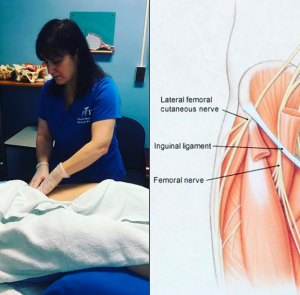Tension along the inguinal ligament can be a cause of groin, hip, genital, abdominal, or pelvic pain. The inguinal ligament attaches to the anterior superior iliac crest of the ilium and inserts onto the pubic tubercle of the pubic bone. The inguinal ligament is formed by the external oblique muscle aponeurosis and continues to be come the fascia lata of the thigh. Many lower quadrant structures are influenced by the inguinal ligament based on its location and surrounding structures. The femoral nerve, artery, and vein run underneath the inguinal ligament and if compressed can cause nerve pain down the anterior thigh. The lateral femoral cutaneous nerve also runs underneath laterally and when compressed can be a cause of meralgia paresthetica. This is characterized by numbness or burning on the outside of the thigh. That is why it is important to assess its length and tension in patients who complain of groin, thigh, lower abdominal or pelvic pain. The inguinal ligament can be sprained causing less support around the pelvic/hip region. This can lead to muscle imbalances of the psoas, gluteals, pelvic floor, and hip adductors and result in groin or pelvic pain. Be sure to also rule out an inguinal hernia. One technique to help heal the sprained inguinal ligament is cross-friction massage. Here in this image we are applying cross friction massage to the inguinal ligament for a patient with post-operative hip labral repair. The trauma to the hip that caused the labral tear and the surgery can cause pain or tension along the inguinal ligament. The cross friction massage helps heal the ligament at a rapid pace. The massage is applied across the fibers to facilitate breakdown of scar tissue and remodel the healing tissue into more flexible and healthy soft tissue that functions normally. The patient generally feels immediate relief of pain.




